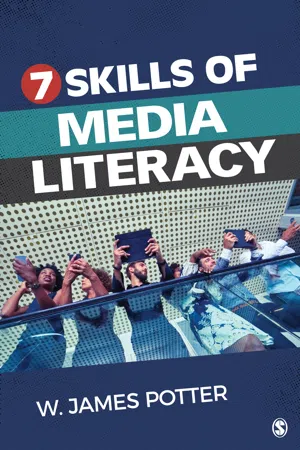
- 192 pages
- English
- ePUB (mobile friendly)
- Available on iOS & Android
Seven Skills of Media Literacy
About this book
In Seven Skills of Media Literacy, best-selling author and renowned scholar W. James Potter provides readers with the practical guidance they need to make substantial improvements on seven major skills required to increase their media literacy. For each of these seven skills, Potter provides easy-to-follow algorithms and heuristics that structure the process of using the skill. Chapters also offer many exercises to help readers practice using these algorithms and heuristics while avoiding traps in thinking. The book is organized to guide readers progressively through the sequence of media literacy skills, starting with the most fundamental and building to the more complex skills. This book is a must read for those people serious about becoming more strategic in using the media to satisfy their own needs for information and entertainment and thereby avoid being exploited by media messages.
Frequently asked questions
- Essential is ideal for learners and professionals who enjoy exploring a wide range of subjects. Access the Essential Library with 800,000+ trusted titles and best-sellers across business, personal growth, and the humanities. Includes unlimited reading time and Standard Read Aloud voice.
- Complete: Perfect for advanced learners and researchers needing full, unrestricted access. Unlock 1.4M+ books across hundreds of subjects, including academic and specialized titles. The Complete Plan also includes advanced features like Premium Read Aloud and Research Assistant.
Please note we cannot support devices running on iOS 13 and Android 7 or earlier. Learn more about using the app.
Information
Chapter 1 Skills in the Context of Media Literacy
- I. What Is Media Literacy?
- Shared Ideas
- Broad Perspective on Media
- Purpose of Protecting and Empowering
- Belief in a Continuum, Not a Category
- Faith That Skills Can Be Developed
- Components
- Skills
- Knowledge Structures
- Personal Locus
- Shared Ideas
- II. Nature of Skills
- Skills Versus Competencies
- What Are the Essential Skills of Media Literacy?
- 1. Analyzing
- 2. Evaluating
- 3. Grouping
- 4. Inducing
- 5. Deducing
- 6. Synthesizing
- 7. Abstracting
- III. Chapter Review
I. What Is Media Literacy?
Shared Ideas
- Media literacy skills should be regarded broadly so their utility is not limited to any one medium or any one type of message;
- The purpose of skills of media literacy is twofold; that is, using these skills can do more than simply protect people from unwanted effects—these skills can also empower people to use the media more strategically to satisfy their individual needs;
- These skills are best regarded along a continuum where we all have some level of ability with them; and
- The skills of media literacy are not static and therefore they can be developed with the right kind of training.
Broad Perspective on Media
Purpose of Protecting and Empowering
Belief in a Continuum, Not a Category
Faith That Skills Can Be Developed
Components
Skills

Knowledge Structures

Table of contents
- Cover
- Half Title
- Publisher Note
- Title Page
- Copyright Page
- Detailed Contents
- Preface
- Chapter 1 Skills in the Context of Media Literacy
- Chapter 2 Importance of Skills
- Chapter 3 Analyzing: Digging Into the Meaning and Structure of Media Messages
- Chapter 4 Evaluating: Making Judgments About the Value of Media Messages
- Chapter 5 Grouping: Classifying Elements in Media Messages
- Chapter 6 Inducing: Looking for Patterns Within and Across Media Messages
- Chapter 7 Deducing: Reasoning with Logic from General Principles
- Chapter 8 Synthesizing: Assembling Novel Configurations
- Chapter 9 Abstracting: Communicating the Essence of Media Messages
- Chapter 10 Putting It All Together
- References
- Glossary